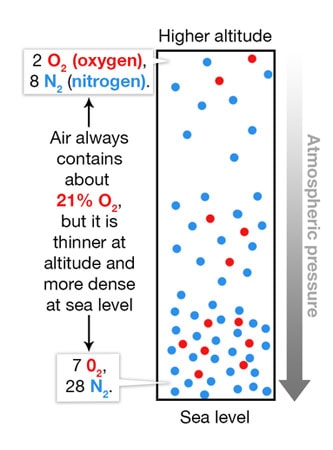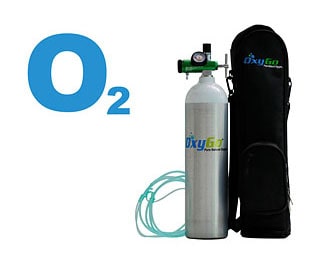Ladakh lies at an elevation over 3,000 metres above sea level. The altitude must be carefully taken into account when planning a trip in the region to prevent Acute Mountain Sickness (AMS) which is also called altitude sickness.
Most tourists reach Ladakh by air and they land at Leh airport. The elevation of Leh (the capital of Ladakh) is 3,500 metres above sea level and you must take 2 days of acclimatization at this height before going to higher altitude. Some of the top attractions in Ladakh are at higher altitude: the Khardung La pass leading to the Nubra valley is at an elevation of 5,602 metres, the altitude of Pangong lake is 4,250 metres and Tso Moriri lake lies at a height of 4,530 metres. You can travel to these places only when you are properly acclimatized to the altitude.
To help you plan your trip in Ladakh without taking any risk with altitude sickness, you should read the recommendations below and follow one of these itineraries.
Study on AMS among tourists reaching Leh by flight and by road
Background: Acute Mountain Sickness (AMS) is commonly experienced by travellers visiting Leh, Ladakh. The aim of this study was to determine the prevalence of AMS depending on the mode of transport used to reach Leh (by flight or by road from Srinagar or Manali).
Methods: Between May and October 2018, a survey was conducted among 3278 tourists in Leh. Within 3 days of their first arrival in Leh, the participants filled in a questionnaire based on the Lake Louise Scoring System (LLSS) in order to quantify the symptoms of AMS. Participants were also asked how they reached Leh: by flight, by road from Srinagar or by road from Manali.
Results: Mild AMS (LLSS ≥ 2) was defined by the presence of mild headache and at least one other symptom: poor appetite, mild fatigue, dizziness or sleep disturbance.
The prevalence of mild AMS was:
- 22 % for participants who reached Leh by flight,
- 31 % for participants who reached Leh by road from Srinagar,
- 57 % for participants who reached Leh by road from Manali.
Note: for participants who reached Leh by road from Manali, 24 % of them suffered from moderate AMS (LLS ≥ 4).
Conclusions:
Flying to Leh and resting for 24 to 36 hours is the best option to reduce the risk of AMS.
Contrary to popular belief, travelling by road from Srinagar to Leh presents a higher risk of AMS than flying to Leh. Indeed, the tiredness caused by the 2-day road journey could prevent the body from acclimatizing properly to the altitude.
Travelling by road from Manali to Leh is strongly discouraged. There is a very high probability of suffering from mild AMS and an increased risk of more severe forms of AMS. The 2-day road journey crosses 3 passes over 5,000m altitude. It should be done at the end of a trip in Ladakh, from Leh to Manali, when already acclimatized to the altitude.
Source: NCBI
How to plan a trip to Ladakh with altitude & acclimatization?
- Visit Leh city, the Indus valley and the Sham region at the beginning of your trip in Ladakh. These places lie at an altitude between 2,700 and 3,700 metres and you can travel around there during acclimatization time.
- Go to the Nubra valley after minimum 2 days of acclimatization. Even though Khardung La pass is at very high altitude (5,602 metres), you will only spend a short time at this elevation and you will be back to a lower altitude when you reach the Nubra valley (3,150 metres).
- Travel to Pangong lake (4,250 metres) after minimum 3 or 4 days of acclimatization. Note that suffering from AMS there can be critical because there is no easy way to drive to lower altitude, you would need to go through Chang La pass (5,360 metres) to get back to Leh.
- Visit Tso Moriri lake (4,530 metres) after minimum 4 days of acclimatization.
- Drive from Leh to Manali or from Leh to Srinagar at the end of your trip in Ladakh.

Oxygen availability and altitude
The pressure of the air that surrounds you is called atmospheric pressure. As the altitude increases, the atmospheric pressure drops and the number of oxygen molecules per breath is reduced. Altitude sickness happens because there is less oxygen in the air that you breathe at high altitude.
Acclimatization to altitude
If you go to high altitude quickly, your body has to adapt to the lack of oxygen: this is acclimatization.
In the short term:
- you breathe faster and more deeply to maximise the amount of oxygen that can get into the blood from the lungs,
- your heart beats faster and pumps more blood to increase the supply of oxygen to your brain and muscles.
In the long term (a few days):
- your body produces new red blood cells (the part of your blood responsible for carrying oxygen), making it easier to supply oxygen to your brain and muscles.
Altitude to oxygen chart
| location | altitude | altitude category | atmospheric pressure | quantity of oxygen molecules per breath |
|---|---|---|---|---|
| sea level | 0m | low | 1.00 atm | 100% |
| Srinagar | 1,580m | medium | 0.83 atm | 83% |
| Manali | 2,050m | medium | 0.78 atm | 78% |
| Kargil | 2,680m | medium | 0.72 atm | 72% |
| Nubra valley | 3,150m | high | 0.68 atm | 68% |
| Leh & Indus valley | 3,500m | high | 0.65 atm | 65% |
| Rohtang La pass | 3,980m | high | 0.61 atm | 61% |
| Pangong lake | 4,250m | very high | 0.59 atm | 59% |
| Tso Moriri lake | 4,530m | very high | 0.57 atm | 57% |
| Taglang La pass | 5,328m | extreme | 0.51 atm | 51% |
| Chang La pass | 5,360m | extreme | 0.51 atm | 51% |
| Khardung La pass | 5,602m | extreme | 0.49 atm | 49% |
For more information, check out the altitude of places of interest in Ladakh.

What is altitude sickness or Acute Mountain Sickness (AMS)?
Altitude sickness is also known as Acute Mountain Sickness (AMS). If you go to high altitude too quickly, your body will not be able to adapt properly to the lack of oxygen and you will suffer from AMS. Altitude sickness can happen to anyone and there is no way to predict it. Some people acclimatize quickly, some people acclimatize slowly. There is no significant effect of age, gender, physical fitness (even Olympic athletes can suffer from AMS).
There are 3 stages of AMS:
- mild AMS,
- moderate AMS,
- severe AMS, which can lead to High-Altitude Cerebral Edema (HACE) and High-Altitude Pulmonary Edema (HAPE).
Preventing altitude sickness
To prevent Acute Mountain Sickness (AMS):
- take 2 or 3 days of acclimatization in Leh or in the Indus valley before going to higher altitude
- avoid increasing your sleeping altitude by more than 500 metres a day (you can go higher during the day, when crossing a pass for example, as long as you sleep at a lower altitude)
- avoid strenuous physical activities, walk slowly
- stay properly hydrated (acclimatization is often accompanied by fluid loss, so you need to drink plenty of water, at least 4 litres per day)
- avoid alcohol and smoking
- eat well, high-calorie and high-carbohydrate meals
- protect yourself from the cold and the sun (hat, sunglasses, sunscreen, clothes)
Mild AMS
Symptoms:
- mild headache
- shortness of breath
- loss of appetite or nausea
- dizziness
- disturbed sleep or insomnia
What to do:
- rest at the same (or lower) altitude until the symptoms disappear
- ibuprofen or paracetamol for headache
- drink enough water
- if not better after 12 hours, go down by at least 500m
Moderate AMS
Symptoms:
- moderate headache
- permanently out of breath
- nausea or vomiting
- decreased coordination (ataxia)
- increasing weakness and fatigue
What to do:
- go down by at least 500m
- use oxygen cylinder (if available)
- drink enough water
Severe AMS
Symptoms:
- strong headache
- severe shortness of breath
- vomiting
- loss of balance, inability to walk
- decreasing level of consciousness, irrational behaviour
- swelling of face or hands
What to do:
- go down by 700m immediately
- use oxygen cylinder (if available)
- call for rescue
- evacuation to a medical facility for treatment (hyperbaric chamber at Leh hospital)

Administering oxygen from a portable cylinder
Oxygen is used to alleviate symptoms of Acute Mountain Sickness (AMS). Anyone suffering from AMS must be taken to lower altitude immediately; an oxygen cylinder will help a sick person while he or she is being taken to lower altitude. The cylinder can deliver oxygen for 3 hours and 30 minutes at 2L/min (flow to be used in case of severe AMS) and for 7 hours at 1L/min (flow to be used in case of mild AMS).
Oxygen cylinders are available for rental when you book a taxi. You still have to follow the acclimatization guidelines even if you rent an oxygen cylinder.
FAQ: Mountain sickness
1. Is there a risk if I come to Leh by road (from Srinagar or Manali)?
Yes, there is a risk of altitude sickness if you drive from Srinagar to Leh. The risk is even higher if you drive from Manali. The best option to avoid altitude sickness is to take a flight to Leh and rest in the city for 24 hours.
2. How much time do I need to acclimatize to the altitude?
Once you reach Leh (by flight), it is recommended to spend 2 or 3 days at the same altitude (3,500m) before going to higher altitude. During this time, you can visit Leh city, discover the monasteries of the Indus valley and explore the Sham region (western Ladakh). Then, you can head to Nubra valley, Pangong lake and Tso Moriri.
3. What do I need to do if I have altitude sickness symptoms?
If you have mild symptoms of AMS, you should rest at the same altitude until the symptoms go away. You need to drink a lot of water and you could take paracetamol.
If you have more severe symptoms of AMS, you have go to lower altitude immediately. If you have rented an oxygen cylinder, use it to reduce the symptoms of altitude sickness. In extreme cases, Leh hospital is equipped to treat AMS (hyperbaric oxygen therapy chamber).
4. Is Diamox necessary for Leh-Ladakh?
The drug Diamox (also known as acetazolamide and normally only available on prescription) has been shown to aid acclimatization in some individuals, and therefore may reduce the risk of AMS. It is a preventative medication, and not a cure.
Diamox could be an option for people going for trekking or mountaineering expeditions. However, if you only do sightseeing tours Ladakh, it is not recommended to use Diamox. You do not need Diamox if your itinerary follows the acclimatization guidelines and if you rent an oxygen cylinder during your trip.
People considering using Diamox should speak to their doctor about the drug, its side effects and a prescription.
5. What’s an oximeter?
An oximeter is a medical device clipped onto the fingertip that measures the oxygen saturation of the blood (SpO2%).
- SpO2% between 95% and 100% = oxygen level in your blood is normal
- SpO2% between 90% and 95% = you still need to acclimatize
- SpO2% below 90% = risk of AMS
Measurements with the oximeter should be done at rest.
